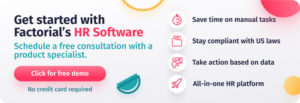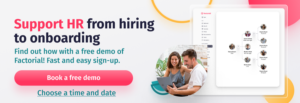Creating a new employee training checklist is one of the most effective ways to ensure a smooth and successful onboarding process. This checklist serves as a structured guide for HR managers, helping to cover all the essential elements new hires need to integrate into the company and perform their roles effectively.
But what should you include in your new employee training checklist?
In this article, we’ll walk you through the key components of a new employee training checklist. Each section will provide practical guidance to help you set up your new hires for success from day one and ensure their ongoing growth and development. That way, with the right approach, you can streamline your training process, improve employee engagement, and enhance long-term retention.
- What Is a New Employee Training Checklist?
- Why You Need a New Employee Training Checklist
- What to Include in Your New Employee Training Checklist
- Ongoing Support and Continuous Learning
- How Factorial’s Onboarding Software Can Help
- Simplify and automate your onboarding process for a seamless new hire experience🚀
What Is a New Employee Training Checklist?
A new employee training checklist, also known as a new hire checklist or an onboarding checklist, is a tool used by HR managers and supervisors to ensure that all essential aspects of onboarding and training for new hires are completed efficiently and systematically. It serves as a guide to make sure nothing important is overlooked during the training process, ensuring a smooth transition for new employees as they integrate into the company.
A new employee training checklist helps HR professionals cover key areas such as workplace policies, job expectations, team introductions, and safety protocols. Each item on the list is designed to prepare the employee for success in their new role, covering both administrative tasks (like completing paperwork) and practical job functions.
Why You Need a New Employee Training Checklist
A new employee training checklist is essential for HR managers to ensure a structured and consistent onboarding process. Without a checklist, crucial training elements can be overlooked, leading to knowledge gaps that can negatively impact employee performance and workplace productivity. By implementing a thorough checklist, you ensure that every new hire receives the same high-quality onboarding experience, regardless of department or location.
A well-organized training program boosts employee engagement, retention, and performance. In fact, according to a study conducted by SHRM, employees who receive structured training are 69% more likely to stay with a company for three years or more. This not only saves the organization time and turnover costs but also helps foster a positive work environment where employees feel supported and prepared for their roles. A checklist helps HR managers streamline this process, ensuring all necessary areas—like compliance training, role-specific skills, and company culture—are addressed.
Moreover, an effective new employee training checklist helps new employees integrate faster, reducing the learning curve. Employees who undergo structured training are more productive in their first few months and can start contributing value sooner. This is particularly important in fast-paced industries where time-to-productivity is critical.
In short, a new employee training checklist sets both the employee and the organization up for success, creating a more efficient, engaged, and productive workforce.
What to Include in Your New Employee Training Checklist
A well-rounded new employee training checklist ensures that each stage of a new hire’s training is thorough and effective, covering all critical areas needed for a smooth integration into the company. By structuring the onboarding checklist into clear, actionable steps, HR managers can ensure that new employees receive the necessary guidance and information to succeed in their roles.
The following sections outline the core elements that should be included in your new employee training checklist.
Pre-Onboarding Preparation
A successful new employee training checklist begins long before the new hire’s first day. Pre-onboarding is an essential step in setting a positive tone and ensuring the new employee is ready to hit the ground running. In this phase, HR teams should focus on gathering all necessary documentation and preparing logistical details to avoid any first-day hurdles. Key items include offer letters, tax forms, benefit enrollment forms, and confidentiality agreements. Having these documents prepared in advance and ready to sign can speed up the overall onboarding process.
Additionally, ensuring that all technology and workspace logistics are in place is crucial. This includes setting up email accounts, providing access to the company’s software systems, and making sure that the employee’s workstation is ready. Whether the employee is working in-office or remotely, it’s important that they have everything they need to begin their job smoothly. You may also want to send a welcome packet or an introductory email explaining the company’s culture and what the new hire can expect on their first day. Including these pre-onboarding essentials in your onboarding checklist will ensure that your new hire feels informed, welcomed, and ready to start.
First Day Orientation
The first day is also crucial for setting the tone for the new hire’s experience. The new employee training checklist should include a detailed first-day orientation, covering both administrative and cultural elements.
Start by welcoming the new hire with a tour of the office (or a virtual orientation for remote workers) and introducing them to their immediate team and key staff members. Orientation should also cover a high-level overview of the company’s mission, values, and long-term goals, giving the new hire a sense of the organization’s purpose. Important administrative tasks, such as completing paperwork and explaining benefits, should also be completed. This initial orientation should set clear expectations for the onboarding schedule, giving the new hire a roadmap for their first few weeks. This helps employees feel welcome and equips them with the foundational knowledge they need to succeed.
Compliance and Legal Training
A key section of any checklist for training a new employee is legal and compliance training. This aspect of onboarding ensures that the company remains compliant with relevant laws and regulations while protecting both the organization and its employees. Your new employee training checklist should include mandatory compliance training on topics such as workplace safety, anti-harassment policies, and data privacy. In certain industries, compliance requirements may extend to specific regulations, like HIPAA in healthcare or OSHA standards in industries involving physical labor. By including comprehensive compliance training, you minimize the risk of legal issues and promote a safe, respectful workplace environment.
Company Policies and Procedures
Every organization has its own set of company policies and procedures that govern workplace behavior. This section of your new employee training checklist should cover these guidelines. This includes everything from HR policies on leave and benefits to rules around company security. By ensuring that employees fully understand these guidelines early on, you reduce the likelihood of misunderstandings or policy violations.
This part of the onboarding checklist should also emphasize organizational values and culture. Employees need to understand the rules of the workplace and the norms that define how business is conducted. The best way to communicate this is with an employee handbook. That way, every new hire has the information they need to thrive.
Role-Specific Training
While general onboarding elements like compliance and company policies are important, the heart of the new employee training checklist is role-specific training. Each new hire needs to be equipped with the specific knowledge and skills required to perform their job effectively. This part of the training should be tailored to the employee’s position and department, focusing on the tools, tasks, and procedures they will use daily.
For example, a marketing employee may need to become proficient in tools like Google Analytics or social media management platforms, while a customer service representative will need training on the company’s CRM system and communication guidelines. Role-specific training should also include an overview of departmental goals, expectations, and workflows. Managers and team leads should be actively involved in delivering this training to ensure that it aligns with departmental objectives.
Introduction to Tools and Technology
Providing training on tools and technology is a non-negotiable part of the new employee training checklist. New hires need to be proficient in the software and platforms your company uses, whether it’s project management tools like Asana or Jira, communication tools like Slack, or industry-specific applications. The onboarding checklist should include dedicated time for software onboarding, with training modules, tutorials, and live walkthroughs to ensure employees can use these tools efficiently.
For remote or hybrid employees, this training becomes even more critical, as these tools will form the backbone of their daily communication and task management. Provide resources such as video tutorials, FAQ documents, and support contacts to help new hires troubleshoot any issues they may encounter. By prioritizing technology training in your checklist for training a new employee, you ensure that they are able to seamlessly integrate into your digital workflows, reducing the learning curve and boosting productivity.
Meet the Team and Departmental Integration
One of the most critical aspects of a new employee training checklist is helping new hires integrate with their team and understand the broader departmental structure. Building relationships and fostering a sense of belonging is key to employee engagement and retention. The new hire checklist should include time for formal introductions to immediate team members, cross-departmental partners, and key leadership figures.
In addition to introductions, team-building activities or collaborative projects can help accelerate the new hire’s integration into the workplace culture. Departmental overviews are also useful for explaining how the new hire’s role fits into the company’s larger objectives. These introductions can take the form of casual coffee chats, team lunches, or virtual meet-and-greets for remote workers. Including these social components in the new employee training checklist helps new hires feel a sense of connection to the team and the organization as a whole.
Mentorship and Buddy System
Implementing a mentorship or buddy system is an effective strategy for accelerating the learning process and providing support during the first few months of employment. This step in the new employee training checklist pairs the new hire with a seasoned employee who can offer guidance, answer questions, and serve as a go-to resource. Peer mentoring can also help new hires better understand company culture, processes, and expectations beyond the formal training program.
In addition to enhancing skill development, mentorships create a sense of belonging and connection for new hires. By having a go-to person to navigate day-to-day challenges, employees feel more supported and confident as they adapt to their new roles. Mentors can offer personalized insights into team dynamics and provide tips for successful collaboration within the company.
Diversity, Equity, and Inclusion (DEI) Training
The final essential component of a new employee training checklist relates to Diversity, Equity, and Inclusion (DEI) training. This training educates new employees on the importance of diversity and inclusion. It also sets clear expectations for how employees can contribute to a more inclusive culture. DEI training may cover topics such as recognizing and mitigating unconscious bias, fostering inclusive communication, and understanding the value that diverse perspectives bring to the organization.
Incorporating DEI initiatives into the onboarding process also demonstrates the company’s commitment to creating a workplace where all employees feel valued and respected. Moreover, DEI training helps reinforce the idea that inclusivity is not just a company policy, but an ongoing practice that enhances collaboration, creativity, and innovation within teams. By embedding DEI initiatives into the new employee training checklist, companies can ensure that all employees, regardless of their background, feel welcomed and empowered to contribute. This builds a foundation for a positive company culture, leading to higher engagement and the long-term retention of talent.
Ongoing Support and Continuous Learning
While initial onboarding is crucial, ongoing support and continuous learning are equally important for employee success. Performance management software plays a pivotal role in extending this support, offering a seamless way to manage and track a new hire’s progress. You can use it to automate tasks, share interactive training modules, and track completion rates. That way, employees receive consistent and comprehensive guidance throughout their journey with you.
Onboarding software can also integrate with Learning Management Systems (LMS) to facilitate continuous development. This ensures that new hires not only master the basics during onboarding but also have access to learning resources for upskilling and adapting to new industry trends. Performance management features are often embedded into these platforms, allowing managers to set goals, provide feedback, and conduct formal reviews. That way, companies can create a tailored, data-driven training experience that evolves with the employee’s role, ensuring long-term engagement and productivity.
How Factorial’s Onboarding Software Can Help
Factorial’s onboarding software offers an efficient and comprehensive solution for managing the onboarding process from start to finish. With its intuitive platform, HR teams can easily automate administrative tasks, track progress, and customize the onboarding experience for each new hire. This ensures that all elements of the new employee training checklist are consistently addressed, helping to create a smoother transition for new employees.
Factorial’s onboarding software assists in various stages of the onboarding process, including:
- Pre-onboarding. Factorial allows HR teams to automate document collection, offer letters, and contract signatures. That way, new hires can complete all essential paperwork before their first day.
- First day orientation. Schedule and organize orientation activities through Factorial’s onboarding portal. This includes virtual or in-person introductions, policy reviews, and training.
- Role-specific training. Factorial’s platform supports customized training modules. That way, new hires receive role-specific instruction that helps them quickly adapt to their responsibilities.
- Compliance and legal training. Factorial automates the assignment and tracking of mandatory compliance training. This includes workplace safety, harassment prevention, and data privacy protocols.
- Ongoing progress tracking. HR managers can monitor training progress and onboarding milestones. This makes it easy to track how well new hires are integrating into the company.
In short, Factorial streamlines the onboarding process and helps you manage each stage of your new employee training checklist. Plus, you can use the platform to track employee L & D beyond onboarding. That way, you can provide a seamless onboarding experience that fosters long-term employee growth, productivity, and satisfaction.



